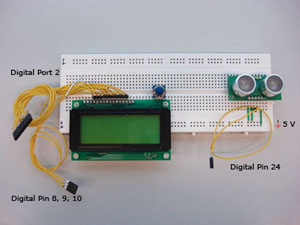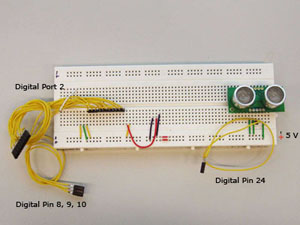Examples - Sensorboard - Supersonic
Supersonic
This Example shows the use of an ultrasonic sensor.


Source - Main
/**************************************************************************************************
*
* Supersonic SRF05
*
* Version: 1.0.0 - September 2008
* Author: Etienne Ribeiro / tutorial assistant caad / eribeiro[at]ethz.ch
* Supervisor: Christoph Wartmann / chair for caad - ETH Zürich / wartmann[at].arch.ethz.ch
*
* Desc: Shows the use of the SRF05 Supersonic Sensor on digital pin.
*
***************************************************************************************************/
// Const
static int digitalPin = 34;
static boolean enableSerial = false;
// (Var)
int lastImp = 0;
// Setup
void setup() {
//LED (2 * blink)
pinMode(48, OUTPUT);
digitalWrite(48, HIGH);
delay(200);
digitalWrite(48, LOW);
delay(200);
digitalWrite(48, HIGH);
// LCD
Display_Clear();
Display_Println("Supersonic LCD");
// Serial (Print to serial if enableSerial = true)
if (enableSerial == true) Serial.begin(9600);
pinMode(digitalPin, INPUT);
}
// Loop
void loop() {
// Trigger pulse
digitalWrite(digitalPin, HIGH);
delayMicroseconds(10);
digitalWrite(digitalPin, LOW);
// Mesure echo pulse
int imp = pulseIn(digitalPin, HIGH);
// LCD
if (imp != lastImp) {
lastImp = imp;
Display_Clear();
Display_Println(" ", imp / 58, " cm");
}
// Serial
if (enableSerial == true) {
Serial.print(imp);
Serial.print(" -> ");
Serial.print(imp / 58);
Serial.println("cm");
}
// Wait
delay(50);
}
Source - LCD Class
/**************************************************************************************************
*
* LCD Class
*
* Version: 1.0.0 - September 2008
* Author: Etienne Ribeiro / tutorial assistant caad / eribeiro[at]ethz.ch
* Supervisor: Christoph Wartmann / chair for caad - ETH Zürich / wartmann[at].arch.ethz.ch
*
* Desc: Library for an 14 Pin LCD Displays.
*
***************************************************************************************************/
#include <LiquidCrystal.h>
// CONST:
const int port = 3; // Port on Wiring Board
const int pins[] = {37, 38, 39}; // Pins on Wiring Board
// VAR
LiquidCrystal myDisplay = LiquidCrystal(pins[0], pins[1], pins[2], port);
int iLine = 0;
// Methodes
void Display_Clear(){
iLine = 0;
myDisplay.clear();
myDisplay.home();
}
void Display_Println(char str[]){
myDisplay.home();
myDisplay.setCursor(0, iLine);
myDisplay.print(str);
iLine += 1;
}
void Display_Println(char str[], char str2[]){
myDisplay.home();
myDisplay.setCursor(0, iLine);
myDisplay.print(str);
myDisplay.print(" ");
myDisplay.print(str2);
iLine += 1;
}
void Display_Println(char str[], int zahl){
myDisplay.home();
myDisplay.setCursor(0, iLine);
myDisplay.print(str);
myDisplay.print(" ");
myDisplay.print(zahl);
iLine += 1;
}
void Display_Println(char str1[], int zahl, char str2[]){
myDisplay.home();
myDisplay.setCursor(0, iLine);
myDisplay.print(str1);
myDisplay.print(" ");
myDisplay.print(zahl);
myDisplay.print(str2);
iLine += 1;
}
void Display_Print(char str[]){
myDisplay.print(str);
}